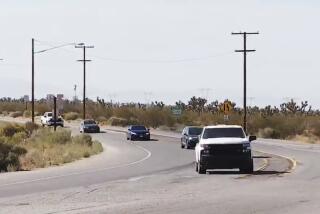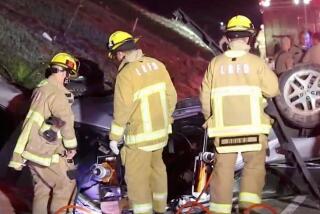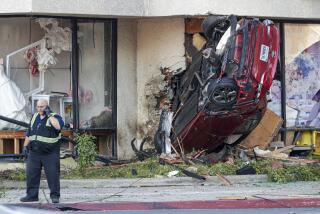SUV Deaths Put Design of Seat Belts in Question
WASHINGTON — Federal officials say they suspect the current design of seat belts fails to provide adequate protection in rollover accidents and have launched a test program to improve the most familiar -- and critical -- piece of auto safety equipment.
The popularity of sport utility vehicles has propelled rollovers to the top of the safety agenda. Rollovers account for 2% of all crashes, but they are the leading killer of people in SUVs and pickups and are a major factor in the rise in highway deaths.
Industry and safety officials have long warned that drivers and passengers in top-heavy vehicles such as SUVs should take extra care to buckle up. That remains the best defense in a rollover. But there is growing recognition that seat belts are not fail-safe.
“You can slip out of the belt,” said Joseph Kanianthra, research chief for the National Highway Traffic Safety Administration. “The belts are designed for holding you in place primarily in a frontal collision. In a rollover, suddenly gravity acts against you. The belt can give way and the occupant can go down.”
The number of belted drivers and passengers killed in SUV rollovers rose from 327 in 1997 to 516 in 2001, according to the NHTSA.
One of the victims was Rosa Rodriguez of Cathedral City, Calif., who was killed last year after she lost control of her new SUV on Interstate 10 near Arizona.
Rodriguez was wearing her seat belt, as were husband Christopher and their three girls, records show. But that didn’t save her or 10-year-old Mackenzie when the family’s 5,000-pound Chevrolet Suburban rolled over. Rodriguez was killed in the vehicle and Mackenzie was ejected during the crash.
“There was no rain, no darkness, no other car,” said Ramona Franco, Rodriguez’s mother. “We don’t understand it.”
Engineers say they are trying to.
Some U.S. automakers are experimenting with a safety device -- called a pre-tensioner -- that would instantly take the slack out of seat belts in a rollover, keeping drivers and passengers more firmly attached to their seats. The new device goes a step beyond the standard locking of the seat belt that drivers feel now when they hit their brakes.
The action of the pre-tensioner would reduce the chances of people slamming their heads on the roof, door frame or some other part of the vehicle in the violent and often unpredictable wrecks.
“What we are looking at pre-tensioning for is to improve the protection people already have when they are buckled up,” said Jim Boland, safety manager for Ford.
Seat belts are effective in preventing adults from being ejected in a rollover -- which is usually fatal -- but “you still see contact with the interior of the vehicle, even the roof, in belted occupants,” Boland said.
Currently, belts are designed to lock down with the sharp drop in speed in a frontal collision. The forces generated in a rollover can be very different. A vehicle may accelerate before coming to a stop.
“The belt design of today is not designed to be holding you in place” in a rollover, said the NHTSA’s Kanianthra.
That’s where a pre-tensioner would come in.
Triggered by a crash sensor, pre-tensioners are used in some newer vehicles to increase safety in frontal collisions.
Most people have an inch or two of slack in their safety belts, and a pre-tensioner tightens the belts as the crash is taking place. In one design, a small explosive charge ignites gas in a chamber, which rapidly expands to drive a piston attached to a cable. The cable pulls the belts, taking out the slack.
In a head-on collision, pre-tensioners help keep front-seat occupants in the best position to benefit from their air bags.
Adapting pre-tensioners for rollovers would require some changes, Boland said. The main one would be the addition of a rollover sensor, more sophisticated than those now used to detect frontal collisions.
For SUVs, “it has to be able to discriminate between those cases where a vehicle is driving over uneven terrain and those where it’s actually going to tip,” Boland said. “That’s where a lot of the research is at the moment.”
Volvo has developed a pre-tensioner system for rollovers and introduced it last year as part of the safety package for its XC90 SUV for 2003.
Seat belts have evolved over decades. In the 1930s, some doctors began installing homemade lap belts in their own cars and advocating their general use. In the early ‘60s, many states began to require lap belts, and the federal government followed suit by the middle of the decade. In 1974, the NHTSA mandated three-point lap and shoulder belts in the front seats of all new vehicles. Other requirements followed for lap and shoulder belts in rear outer seats, and adjustable shoulder belts in front seats. The government estimates that seat belts have saved nearly 150,000 lives since 1975.
Manufacturers already recognize pre-tensioners as an improvement in seat belt technology. But there is no federal requirement for them.
NHTSA officials say they are testing pre-tensioners in conjunction with other technology that could increase the odds of rollover survival and decrease the likelihood of such crashes.
To protect people buckled up inside the vehicle, the NHTSA said it will require stronger vehicle roofs more resistant to crushing. Agency spokesman Rae Tyson said pre-tensioners and stronger roofs appear to be a combination that will increase safety. “The current thinking is we may need to address both problems in order to resolve the issue of belted rollover injuries,” he said.
Most people who die in rollovers are unbelted, which greatly increases their chances of being ejected. To prevent ejection, the agency is evaluating side air bags and special window glazing.
And to reduce the chances of rollovers, the NHTSA is testing electronic systems that can sense when a vehicle is starting to go out of control and operate the brakes and engine more rapidly than would a driver.
It usually requires several years for government auto safety standards to be approved and take effect.
Meanwhile, a national trend toward greater seat belt use and the continued market appeal of SUVs are likely to produce more rollover victims who took the precaution of buckling up.
“SUV drivers ... in increasing numbers are buckling up, but they are being killed anyway,” said Randy Whitfield, an auto safety consultant critical of SUVs. “It may be an indicator of where the future of this problem is going.”
That could create greater urgency to improve seat belts.
Surveys show that most SUV owners like their vehicles because they feel safer. But most motorists are not aware of the dynamics of rollovers or the limits of seat belts.
Rosa Rodriguez had bought her white Chevrolet Suburban partly because she thought it would provide added protection. “It was a very strong car,” said her mother.
The accident last summer happened as Rodriguez and her family headed to a niece’s high school graduation in Blythe, Calif.
Rodriguez was 32, a hairstylist who had grown up in the area. Her obituary said she played the organ at a local Roman Catholic church for years at weddings and special religious observances. Rodriguez was a stickler about auto safety with her children.
“My daughter was very conscientious,” Franco said. “Before she started the car, she made it like a game: ‘What are we going to do with the seat belts?’ They were all wearing their belts.”
The California Highway Patrol said Rodriguez drifted into the median and then made a sharp turning movement, causing her SUV to slide sideways, then flip.
Coroner Mike Presley, who investigated the deaths, said Rodriguez did not appear to have been speeding.
“I think it was just inattention,” Presley said. “They were getting ready. Maybe she was trying to deal with the kids in the back. They were going to have a wonderful night.”
The mother and stepdaughter were pronounced dead at the scene. Rodriguez was found behind the steering wheel of the upside-down SUV. She died of neck and head injuries.
Mackenzie, who was ejected, died of brain trauma.
Christopher Rodriguez was sitting in the front passenger seat and suffered facial injuries. Daughters Jordan, 6, and Cassidy, 7, suffered head and abdominal injuries, respectively.
When an SUV flips, the people in it are thrown into chaos, said R. David Pittle, vice president for technical issues with Consumers Union.
“These accidents can be so severe that wearing or not wearing a seat belt may just alter the mode of death,” Pittle said. “It’s worse when you are unbelted, but it’s no picnic for the belted driver, either.”






